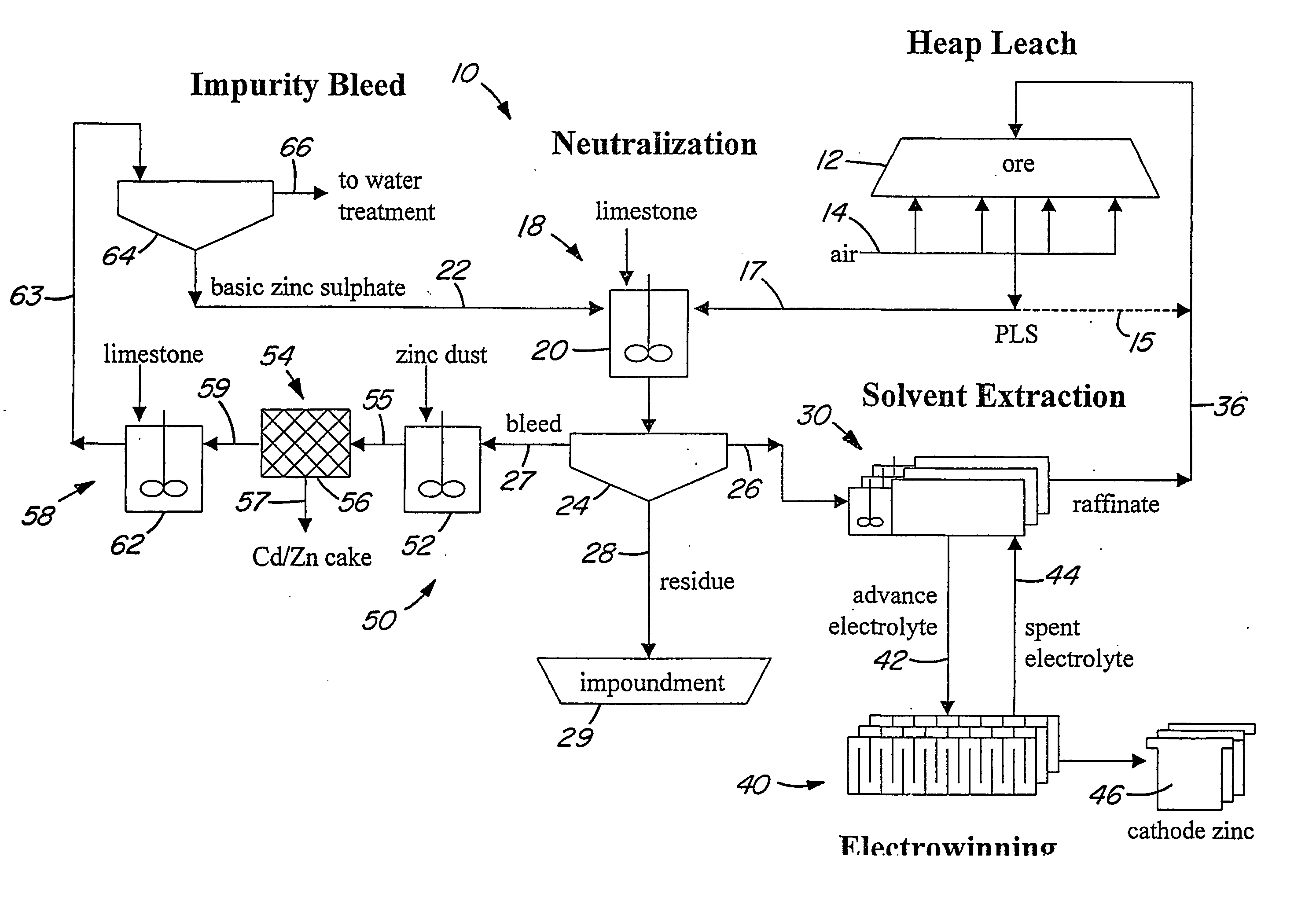Heap bioleaching process for the extraction of zinc
a bioleaching and heap technology, applied in the field of bioleaching of zinc, can solve the problems of not being applied to the recovery of zinc, percolation problems, percolation and irrigation problems, etc., and achieve the effect of avoiding iron precipitation in the heap and sufficient acid conten
- Summary
- Abstract
- Description
- Claims
- Application Information
AI Technical Summary
Benefits of technology
Problems solved by technology
Method used
Image
Examples
example 1
This example demonstrates that various grades of zinc ores are treatable by the process and encouraging zinc extraction rates are achievable.
The graph in FIG. 5 shows the results from an experiment where three different grades of an ore were tested. All three ore samples had a maximum particle size of −12.7 mm.
This preliminary test encouraged further development of the process. All of the ores showed good extraction rates in the earlier stages of the leach. Although more zinc was recovered from the higher grade ores, further process development could result in higher leaching rates for all ores that would meet an extraction rate of 2.5 kg / m2·d. This example clearly demonstrates the applicability of the process to ores of different grades. The process is not restricted to any particular ore grade. It is conceivable that very low grade ores (below 5%) could be treated by the process at appropriate conditions, such application being dependent on economics. Such material could be t...
example 2
This example demonstrates that some ores are more amenable to bioleaching than other ores.
Bench scale amenability testing was carried out using ore samples of varying grades for a number of deposits. Amenability testing uses finely ground samples of whole ore in stirred reactors in a fixed pH environment, inoculated with a mesophile bacteria culture. The leaching test is run for 21 days at ambient temperature.
Because the ore is finely ground, leaching rates are high when compared to agglomerated crushed ore, as expected. Leaching rates, using normalized units to account for variations in particle size, vary according to the mineralogy of the ores and leaching results are observed to depend on ore type as shown in Table 1.
TABLE 1Variability of leaching rates fordifferent deposit types.NumberRelative leaching ratestestedHighLowAverageCRD32.80.631.0VMS22.41.92.1Sedex14123.26.5
CRD = carbonate replacement deposits
VMS = volcanogenic massive sulphide deposits
Sedex = sedimentary ex...
example 3
This example demonstrates that ore sizing is an important parameter for acceptable zinc leaching rates.
The graph in FIG. 6 shows the results from an experiment where ore from the Red Dog district in Alaska was crushed and screened to four different maximum sizes and tested. Each ore size was agglomerated. The ore grade was 15% zinc and the distribution of sizes was from −6.4 mm to −50.8 mm.
The results clearly indicate generally acceptable leaching rates for all ore sizes tested. The results show how crush size of the ore begins affecting the leaching rate at a sizing of 12.7 mm. A maximum size of about 12 mm would be desirable; however, the process remains feasible up to 25 mm and possibly even up to 50 mm under the correct conditions.
PUM
| Property | Measurement | Unit |
|---|---|---|
| particle size | aaaaa | aaaaa |
| concentration | aaaaa | aaaaa |
| concentration | aaaaa | aaaaa |
Abstract
Description
Claims
Application Information
 Login to View More
Login to View More - R&D
- Intellectual Property
- Life Sciences
- Materials
- Tech Scout
- Unparalleled Data Quality
- Higher Quality Content
- 60% Fewer Hallucinations
Browse by: Latest US Patents, China's latest patents, Technical Efficacy Thesaurus, Application Domain, Technology Topic, Popular Technical Reports.
© 2025 PatSnap. All rights reserved.Legal|Privacy policy|Modern Slavery Act Transparency Statement|Sitemap|About US| Contact US: help@patsnap.com



